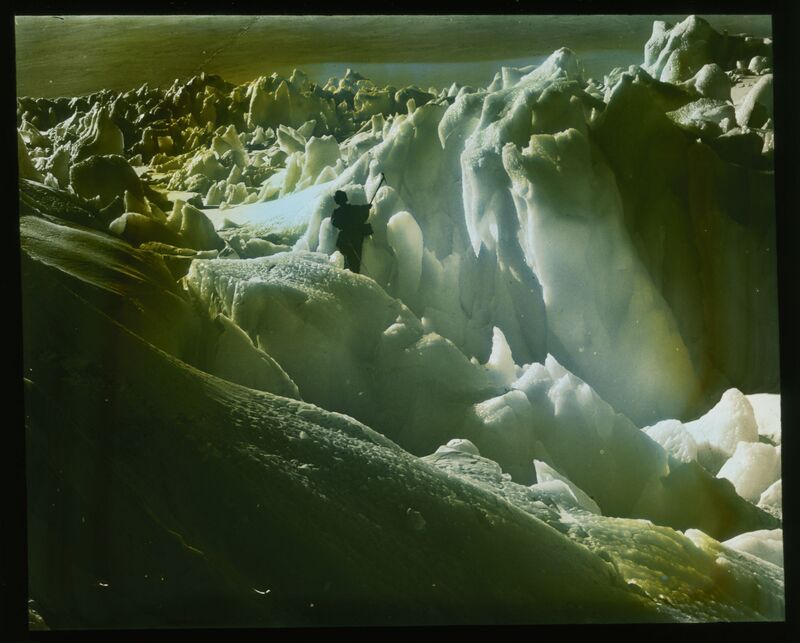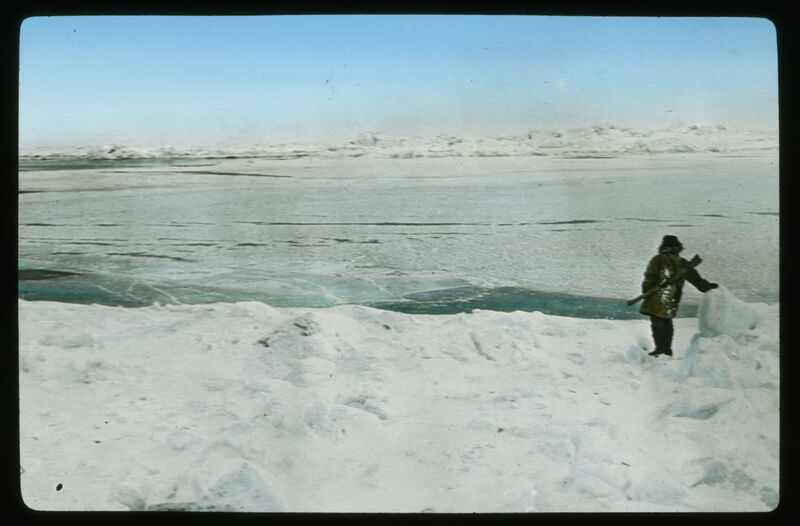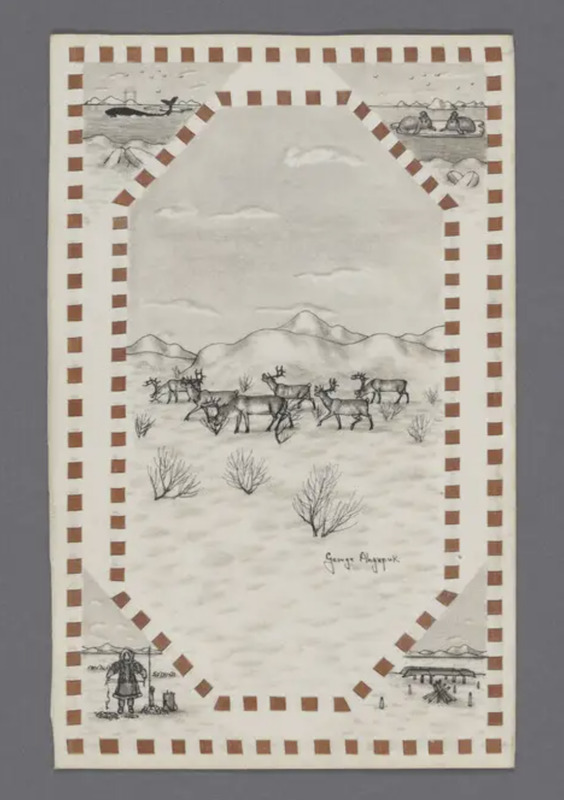Screens, Etchings, and Ilustrations
Western Perspectives
These two lantern slides come from the Stefansson Collection of Arctic Photographs and were originally produced between 1906 and 1907. The hand-tinted glass lantern slides have been digitized, but were at first made with the intention of showing off the wonders of polar lands to convince wealthy individuals to donate to expedition funds. The lantern slide was the forerunner of modern slide projectors, and these in particular certainly speak to the ways that Western explorers used etchings to illustrate their Arctic and Anarctic perceptions.
Indigenous Perspectives
"When Inuit artists represent their own landscapes, it reflects that deep connection to the land through their lived experiences"
- Leanne Inuarak-Dall
Sheouak Petaulassie's Reflections in My Mind is a stonecut print on laid Japan paper, depicting foxes and reflection of foxes across overlaid landscapes. Petaulassie was an Inuit graphic artist from Cape Dorset, Nunavut Territory, Canada, known for her dream-like and mystifying landscape and animal prints. Reflections in My Mind follows this theme, with solidly colored landscape blocks contrasting topography and relfections. While the stacked landscapes show repeated reflections of the foxes, the changing positions of the foxes indicate a deeper meaning. The reflections rather reflect the concept of inua (Iñupiaq), a recognition that all things, including objects, animals, and humans, have a unique inner spirit and essence. Petaulassie uses these reflections as a way to view the world beyond the physical earth, accessing the spirit of the foxes and emphasizing the depth of the natural world and stories associated with indigenous landscape imaging. Her landscape imagery shows not only the physical foxes and land upon which they walk, but the story the land tells, bringing forth the powerful connection between Indigenous peoples and the Arctic land.
George Twok Aden Ahgupuk uses pen and ink wash on bleached seal skin in his unititled work, with a border of red alder-dyed reindeer skin along the side. He depicts a winter scene of a caribou herd as the focus, with smaller landscapes of animals and Iñupiaq lifestyles in each corner. Ahgupuk was from the Inupiat Native village of Shishmaref, Alaska, where he grew up sketching village scenes of Arctic native life. He developed his own technique for bleaching caribou/reindeer and moose hides which he used as his drawing mediums. Ahgupuk drew on the stark contrast between his native lifestyle and that of the "white man", as he spent the fishing season as a commercial fisherman to earn a living for his family and created artwork to sell both as original works to Alaskan tourists and later to commercial souvenir companies. His artwork, as is the case with this piece, emphasizes the life of indigenous villagers in Alaska, highlighting traditional hunting and fishing practices as well as natural landscapes. He tells the story of life in Alaska, combining people with elements of the natural world to emphasize the connection he grew up having with the environment. While western illustrations of Arctic landscapes often depict the land as idyllic, untouchable, and vast, Ahgupuk emphasizes the indigenous unity with the land, and its role as a hospitable landscape for villages and cultures to thrive.
Sources:
Indigenous
DaVic Gallery of Native Canadian Arts. ““Reflections in My Mind" by Sheouak Petaulassie | Native Canadian Arts.” Accessed May 28, 2023. https://nativecanadianarts.com/gallery/reflections-in-my-mind/.
DaVic Gallery of Native Canadian Arts. “Sheouak Petaulassie - Inuit Artist, Cape Dorset | Native Canadian Arts.” Accessed May 28, 2023. https://nativecanadianarts.com/artist/sheouak-petaulassie/.
Inuarak-Dall, Leanne. “8 Arctic Landscapes by Inuit Artists.” Inuit Art Foundation, May 14, 2021. https://www.inuitartfoundation.org/iaq-online/8-arctic-landscapes-by-inuit-artists.
Olcott, Hillary C. “New Publication: ‘Yua, Spirit of the Arctic.’” the de Young Fine Arts Museums of San Francisco, October 9, 2020. https://www.famsf.org/stories/publication-yua-spirit-of-the-arctic.
Western
Hurley, J. F.". Amongst splinterd ice where the ice-sheet descends to the sea near Cape Denison, 1906. Digital by Dartmouth Library. https://n2t.net/ark:/83024/d4qb9v982.
Stefansson, Vilhjalmur, 1879-1962. "The open lead on March 29, 1914", 1906. Digital by Dartmouth Library. https://n2t.net/ark:/83024/d4sq8qp0h.
About Lantern Slides: Lantern Slides Project. About Lantern Slides | Lantern Slides Project. (n.d.). https://www.brown.edu/Departments/Joukowsky_Institute/resources/lanternslides/2513.html




